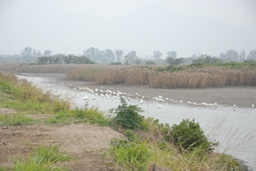Why Ibn Khaldun Still Matters for Urban Sustainability
Published in Earth & Environment and Philosophy & Religion

Our paper began with a deceptively simple question: What if the future of sustainable cities lies in the past?
In late 2022, amid a seminar on urban resilience and climate adaptation, we found ourselves returning—not to the latest climate report or city dashboard—but to a 14th-century polymath: Ibn Khaldun. Best known for The Muqaddimah, his writings explored how civilizations rise and fall not only through material strength, but through climate sensitivity, governance foresight, and what he called ‘asabiyyah—social cohesion.
At first, this felt like an intellectual detour. But as climate risks mount and many modern cities rely on increasingly energy-intensive interventions, Khaldun’s warning felt eerily timely: no civilization can endure if it loses its moral and ecological compass.
This paper was not easy to write. Interpreting a medieval framework through contemporary lenses required months of comparative reading and debate. We wrestled with balancing historical fidelity and modern relevance, resisting both romanticization and reduction. The breakthrough came when we juxtaposed three cities—Stockholm, Dubai, and Phoenix—as case studies to test Khaldun’s theory of climate zones and civilizational dynamics in real-world contexts.
We found that while technological innovation can buffer climate extremes, true resilience is rooted in governance models that align with nature and people. Stockholm’s participatory urbanism stands in contrast to Dubai’s engineered defiance of desert heat and Phoenix’s mixed strategies. Each illustrates, in its own way, the risks and rewards of trying to “build against” versus “build with” nature.
Beyond the cities themselves, this work is also about disciplines meeting each other halfway. A geographer, a cultural theorist, and a scholar of Muslim diasporas might seem like unlikely collaborators. But it’s this convergence that allowed us to see Ibn Khaldun not just as a historian of his time, but as a theorist for our time.
We hope this paper opens a dialogue—not only on how to plan more sustainable cities, but on whose knowledge counts in sustainability science. History, especially non-Western intellectual traditions, has much to offer if we are willing to listen.
If we’ve learned anything, it’s this: The sustainability of cities may hinge less on how smart their buildings are, and more on how wisely they are governed—and how deeply they are rooted in shared values. Ibn Khaldun understood that. The question is: do we?
Follow the Topic
-
SN Social Sciences

This is a multi- and interdisciplinary journal serving the Social Sciences community.
Related Collections
With Collections, you can get published faster and increase your visibility.
- SDG 04 - Quality Education
We are calling for articles to our new Collection on Quality Education, in support of the UN Sustainable Development Goal: SDG 4. This collection creates a cross-disciplinary space for researchers and stakeholders working across various disciplines to address this significant global issue. We bring together scholarship and policy that aims to contribute to the provision of quality education for a sustainable future.
The aim of SDG4 is to provide equal access to affordable vocational training, eliminate gender and wealth disparities, and achieve universal access to quality higher education. Education helps to reduce inequalities and to reach gender equality. It also empowers people everywhere to live more healthy and sustainable lives. Education is also crucial to fostering tolerance between people and contributes to more peaceful societies.Education is the key that will allow many other Sustainable Development Goals (SDGs) to be achieved. When people are able to get quality education they can break from the cycle of poverty.
We are welcoming a range of perspectives including theoretical, methodological, quantitative and qualitative studies. Original Research and Review Papers are accepted. We are specifically interested in research that advances understanding on:
- By 2030, ensuring that all girls and boys complete free, equitable and quality primary and secondary education leading to relevant and Goal-4 effective learning outcomes
- The provision of all girls and boys access to quality early childhood development, care and preprimary education so that they are ready for primary education
- Ensuring equal access for all women and men to affordable and quality technical, vocational and tertiary education, including university
- Substantially increasing the number of youth and adults who have relevant skills, including technical and vocational skills, for employment, decent jobs and entrepreneurship
- By 2030, eliminating gender disparities in education and ensure equal access to all levels of education and vocational training for the vulnerable, including persons with disabilities, indigenous peoples and children in vulnerable situations
- Ensuring that all youth and a substantial proportion of adults, both men and women, achieve literacy and numeracy
- Enabling all learners to acquire the knowledge and skills needed to promote sustainable development sustainable lifestyles, human rights, gender equality, promotion of a culture of peace and non-violence, global citizenship and appreciation of cultural diversity and of culture’s contribution to sustainable development - Building and upgrading education facilities that are child, disability and gender sensitive and provide safe, nonviolent, inclusive and effective learning environments for all
- The substantial expansion globally of the number of scholarships available to developing countries for enrolment in higher education, including vocational training and information and communications technology, technical, engineering and scientific
- By 2030, substantially increase the supply of qualified teachers, including through international cooperation for teacher training in developing countries, especially least developed countries and small island developing states
Submission Procedure:
Submission is possible to one of the participating journals on the right, please select TC: SDG4 - Quality Education in the electronic submission portal. Accepted articles will be published in the respective journal, as well as highlighted on the Collection page.
Publishing Model: Hybrid
Deadline: Dec 31, 2030





Please sign in or register for FREE
If you are a registered user on Research Communities by Springer Nature, please sign in